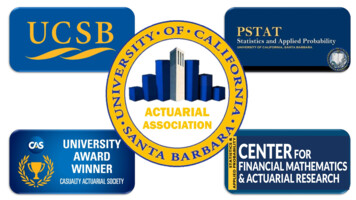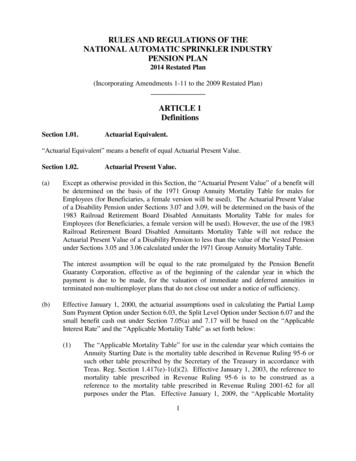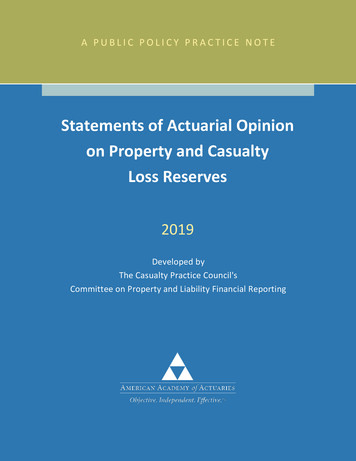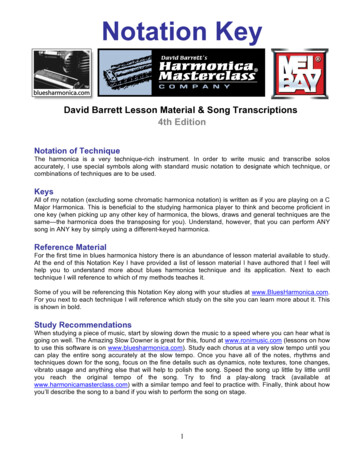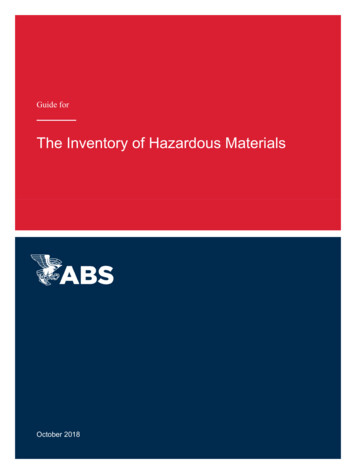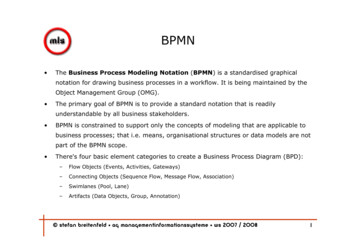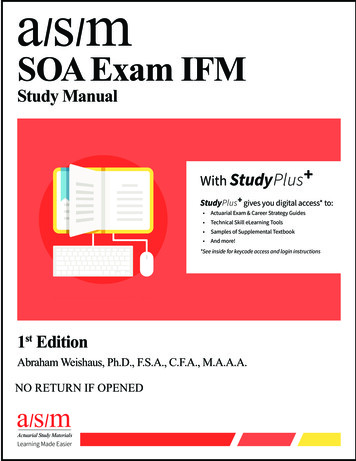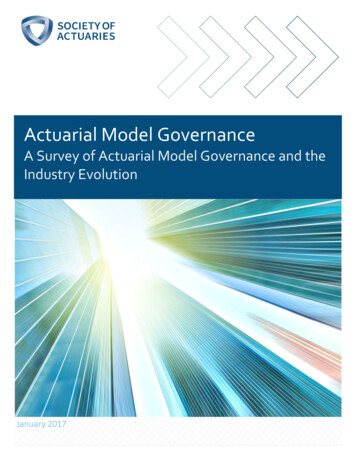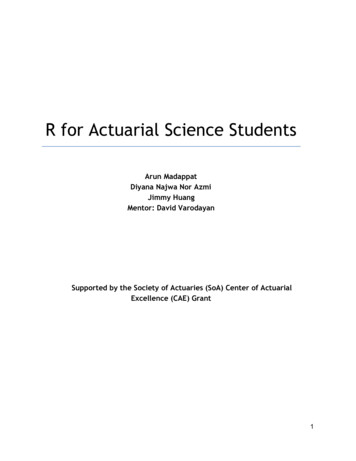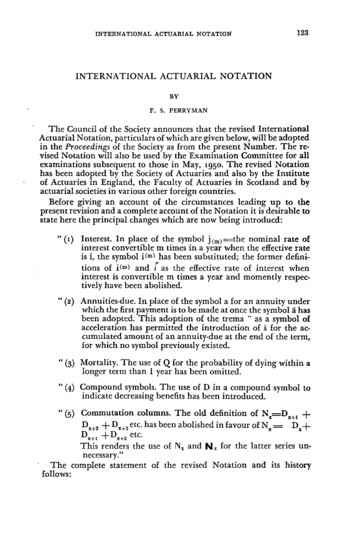
Transcription
INTERNATIONAL ACTUARIAL NOTATION123INTERNATIONAL ACTUARIAL NOTATIONBYF. S. P E R R Y M A NT h e Council of the Society announces that the revised InternationalActuarial Notation, particulars of which are given below, will be adoptedin the Proceedings of the Society as from the present Number. T h e revised Notation will also be used by the Examination Committee for allexaminations subsequent to those in May, 195o. T h e revised Notationhas been adopted by the Society of Actuaries and also by the Instituteof Actuaries in England, the Faculty of Actuaries in Scotland and byactuarial societies in various other foreign countries.Before giving an account of the circumstances leading u p to thepresent revision and a complete account of the Notation it is desirable tostate here the principal changes which are now being introducd:"0)Interest. In place of the symbol j ( m ) t h e nominal rate ofinterest convertible m times in a year when the effective rateis i, the symbol i(m has been substituted; the former definitions of i(m) and /" as the effective rate of interest wheninterest is convertible m times a year and momently respectively have been abolished."( ) Annuities-due. I n place of the symbol a for an annuity u n d e rwhich the first payment is to be made at once the symbol i hasbeen adopted. This adoption of the trema "" as a symbol ofacceleration has permitted the introduction of for the accumulated amount of an annuity-due at the end of the term,for which no symbol previously existed." (3) Mortality. T h e use of Q for the probability of dying within alonger term than 1 year has been omitted." (4) Compound symbols. T h e use of D in a compound symbol toindicate decreasing benefits has been introduced." (5) Commutation columns. T h e old definition of N D x , qDx 2 -31-Ox 3 etc. has been abolished in favour of N x Dx- Dx I -]-D etc.This renders the use of N and I l for the latter series unnecessary."T h e complete statement of the revised Notation and its historyfollows:
124INTERNATIONALACTUARIAL NOTATIONThe existing international actuarial notation was founded on the ' Key to theNotation' given in the Institute of Actuaries Text-Book, Part II, Life Contingencies, by George King, and is embodied in an explanatory statementadopted unanimously by the Second International Actuarial Congress held inLondon in May I898 and printed on pp. 6t8-4o of the Transactions of thatCongress. At the Third International Congress held in Paris ili June I9OO afurther statement by Dr Sprague was submitted which rearranged the symbolsin different orders and grouped them on different principles but did not introduce any changes in the symbols themselves beyond two slight additions. Thisstatement is printed on pp. 622-5I of the Transactions of that Congress. At theEleventh International Congress held in Paris in June i937 an InternationalCommittee was appointed to consider the question of notation and given theduty of submitting definite proposals to the next Congress. This Committeemet in Brussels in July I938 and again in July 1939, and certain changes wouldhave been proposed for adoption at Lucerne in 194o. Owing to the war this couldnot be done, but in order not to lose the benefit of these changes for an indefiniteperiod the Institute of Actuaries and the Faculty of Actuaries have decided toadopt at a date to be mutually arranged those recommendations which hadreceived unanimous or substantial support at the meetings of the Committee.As many students and members of the profession have not ready access tothe above-mentioned Transactions it has been thought desirable to prepareand issue the following statement of the International Actuarial Notation afterembodying in it the changes arising from the recommendations mentionedabove.T h e general principles on which the system is based are as follows:T o each fundamental symbolic letter are attached signs and letters eachhaving its own signification.The lower space to the left is reserved for signs indicating the conditionsrelative to the duration of the operations and to their position with regard totime.The lower space to the right is reserved for signs indicating the conditionsrelative to ages and the order of succession of the everits.The upper space to the right is reserved for signs indicating the periodicityof the events.The upper space to the left is free, and in it can be placed signs correspondingto other notions.In what follows these two conventions are used:A letter enclosed in brackets, thus (x), denotes 'a person aged x'. A letter ornumber enclosed in a right angle, thus n--]or i-g], denotes a term-certain of years.F U N D A M E N T A L SYMBOLIC L E T T E R SInteresti the effective rate of interest, namely, the total interest earned on I in a yearon the assumption that the actual interest (if receivable otherwise thanyearly) is invested forthwith as it becomes due on the same terms as theoriginal principal.
INTERNATIONAL ACTUARIAL NOTATION125v (x i ) - t the present value of I due a year hence.d i - v the discount o n i due a year hence.3 loge(x i ) - loge(i - d ) the force of interest or the force of discount.M o r t a l i t y Tablesn u m b e r living.n u m b e r dying.probability of living.probability of dying.force of mortality.central death rate.present value of an a n n u i t y .a m o u n t of an a n n u i t y .expectation of life.present value of a n assurance.present value of an e n d o w m e n t .p r e m i u m per a n n u m . P generally refers to net p r e m i u m s , rr to specialpremiums.V policy value.W p a i d - u p policy.ldpq/,maseAEP} T h e m e t h o d s of u s i n g the foregoing principal letters a n d their precisem e a n i n g w h e n added to b y suffixes, etc., follow.Interesti era) m{(i i) lt' - i} the n o m i n a l rate of interest, convertible m times a year.a v v . . . v" the value of an a n n u i t y - c e r t a i n of I per a n n u m forn years, the p a y m e n t s being made at the e n d of each year./ I v v - . . . v -x the value of a similar a n n u i t y , the p a y m e n t s beingm a d e at the b e g i n n i n g of each year.s i (i i ) (i i)2 . . . (i i) "-x the a m o u n t of an a n n u i t y - c e r t a i n ofI per a n n u m for n years, the p a y m e n t s being made at the e n d of each year. (I i) (I i)2 .,. (I i)" the a m o u n t of a similar annuity, thep a y m e n t s being made at the b e g i n n i n g of each year.T h e diaeresis or trema above the letters a and s is used as a s y m b o l ofacceleration of payments.3 I o r t a l i t y TablesT h e ages of the lives involved are d e n o t e d by letters placed as suffixes in thelower space to the right. T h u s :lz the n u m b e r of persons who attain age x according to the mortality table.d z l -I,: l the n u m b e r of persons who die between ages x and x taccording to the mortality table.Px the probability that (x) will live I year.qx the probability that (x) will die w i t h i n x year.
126INTERNATIONALACTUARIAL NOTATIONi dl Px - - the force of mortality at age x.mx the central death-rate for the year of age x to x t dz/ flolx ,dt.ex the curtate 'expectation of life' (or average after-lifetime) of (x).I n the following it is always to be understood (unless otherwise expressed)that the annual payment of an annuity is , that the sum assured in any case is x,and that the symbols indicate the present values:a an annuity, first payment at the end of a year, to continue during thelife of (x).i a z an ' a n n u i t y - d u e ' to continue during the life of (x), the firstpayment to be made at once.A x an assurance payable at the end of the year of death of (x).Note. % a at rate of interest i o.A letter or n u m b e r at the lower left corner of the principal symbol denotes then u m b e r of years involved in the probability or benefit in question. T h u s :,,p the probability that (x) will live n years.,q the probability that (x) will die within n years.Note. W h e n n I it is customary to omit it, as shown on page z, providedno ambiguity is introduced.,E v%p x the value of an endowment on (x) payable at the end of n yearsif (x) be then alive.I f the letter or n u m b e r comes before a perpendicular bar it shows that aperiod of deferment is meant. T h u s :,rq the probability that (x) will die in a year, deferred n years; that is, thathe will die in the (n i)th year., la an annuity on (x) deferred n years; that is, that the first payment is tobe made at the end of (n i) years.,ltax an intercepted or deferred temporary annuity on (x) deferred n yearsand, after that, to run for t years.A letter or n u m b e r in brackets at the upper right c o m e r of the principalsymbol shows the n u m b e r of intervals into which the year is to be divided.Thus:a m x an annuity on (x) payable by m instalments of x/m each throughout theyear, the first payment being one of I/m at the end of the first i/ruthof a year. / ' z a similar annuity b u t the first payment of i/m is to be made at once,so thata " '" I / m a ' At,. x an assurance payable at the end of that fraction i[m of a year in which(x) dies.
INTERNATIONAL ACTUARIAL NOTATION127I f m-- oo then instead of writing (co) a bar is placed over the principalsymbol. T h u s : a continuous or momently annuity. an assurance payable at the moment of death.A small circle placed over the principal symbol shows that the benefit is to becomplete. Thus:ao a corn pl ete annuity. the complete expectation of life.Note. Some consider that would be as appropriate as 8. As ex ax at rateof interest i o, so also the complete expectation of life z at rate ofinterest i o.W h e n more than one life is involved the following rules are observed:I f there are two or more letters or numbers in a suffix without any distinguishing mark, joint lives are intended. T h u s :ltu lx x l wd u txu -l l:u l.Note. When, for the sake of distinctness, it is desired to separate theletters or numbers in a suffix, a colon is placed between them. A colonis used instead of a point or comma to avoid confusion with decimalswhen numbers are involved.a an annuity, first payment at the end of a year, to continue during thejoint lives of (x), (y) and (z).A u an assurance payable at the end of the year of the failure of the jointlives (x), (y) and (z).I n place of a life a term-certain may be involved. T h u s :ax: an annuity to continue during the joint duration of the life of (x) and aterm of n years certain; that is, a temporary annuity for n years on thellfe of (x).A : an assurance payable at the end of the year of death of (x) if he diewithin n years, or at the end of n years if (x) be then alive; that is, anendowment assurance for n years.If a perpendicular bar separates the letters in the suffix, then the status afterthe bar is to follow the status before the bar. T h u s :aul a reversionary annuity, that is, an annuity on the life of (x) after thedeath of (y).A l u an assurance payable on the failure of the joint lives (x) and (y) providedboth these lives survive (z).If a horizontal bar appears above the suffix then survivors of the lives, andnot joint lives, are intended. T h e number of survivors can be denoted by a letteror number over the right end of the bar. If that letter, say r, is not distinguishedby any mark, then the meaning is at least r survivors; but if it is enclosed insquare brackets, [r], then the meaning is exactly r survivors. I f no letter or
128INTERNATIONALACTUARIAL NOTATIONn u m b e r appears over the bar, then unity is supposed and the meaning isat least one survivor. Thus:a 7 an annuity payable so long as at least one of the three lives (x), (y) and(z) is alive.2a - an annuity payable so long as at least two of the three lives (x), (y) and(z) are alive.p[21 probability that exactly two of the three lives (x), (y) and (z) will survivea year.nq probability that the survivor of the two lives (x) and (y) will die withinn years nqz nqwn A an assurance payable at the end of the year of death of the survivor ofthe lives (x) and (y) provided the death occurs within n years.When numerals are placed above or below the letters of the suffix, theydesignate the order in which the lives are to fail. T h e numeral placed over thesuffix points out the life whose failure will finally determine the event; and thenumerals placed under the suffix indicate the order in which the other livesinvolved are to fail. Thus:A y an assurance payable at the end of the year of death Of (x) if he diesfirst of the two lives (x) and (y).A x zs an assurance payable at the end of the year of death of (x) if he diessecond of the three lives (x), (y) and (z).A y: an assurance payable at the end of the year of death of (x) if he dies1 second of the three lives, (y) having died first.A : an assurance payable at the end of the year of death of the survivor of,a (x) and (y) if he dies before (z).1 an assurance payable at the end of the year of death of (x) if he diesAx:nlwithin a term of n years.a2ol; [ an annuity to (x) after the failure of the survivor of (y) and (z),a lx provided (z) fails before (y).Note. Sometimes to make quite clear that a joint-life status is involved asymbol is placed above the lives included.life temporary assurance on (x) and (y).T h u s A : a jointIn the case of reversionary annuities, distinction has sometimes to be madebetween those where the times of year at which payments are to take place aredetermined at the outset and those where the times depend on the failure ofthe preceding status. Thus:a lz annuity to (x), first payment at the end of the year of the death of (y) or,on the average, about 6 months after his death. vlx annuity to (x), first payment i year after the death of (y).8 complete annuity to (x), first payment I year after the death of (y).a l
INTERNATIONAL ACTUARIAL NOTATION129A N N U A L PREMIUMSThe symbol P with the appropriate suffaxor suflq.xesis used in simple cases,where no misunderstanding can occur, to denote the annual premium for abenefit. Thus:Pz the annual premium for an assurance payable at tile end of the year ofdeath of (x).Px:n-'] the annual premium for an endowment assurance'on (x) payable aftern years or at the end of the year of death of (x) if he die within n years.P } the annual premium for a contingent assurance payable at the end ofthe ),ear of death of (x) if he die before (y).In all these cases it is optional to use the symbol P in conjunction with theprincipal symbol denoting the benefit. T h u s instead of Px: we may writeP(A : ). In the more complicated cases it is necessary to use the two symbolsin this way. Suffixes, etc., showing the conditions of the benefit are to beattached to the principal letter, and those showing the conditions of paymentof the premium are to be attached to the subsidiary symbol P. T h u s :nP(Ax) the annual premium payable for n years only for an assurancepayable at the moment of the death of (x).P (A ) the annual premium payable during the joint lives of (x) and (y)for an assurance payable at the end of the year of death of (x).nP(n]ax) the annual premium payable for n years only for an annuity on(x) deferred n years.,PCm (Ax: ) the annual premium payable for t years only, by m instalmentsthroughout the year, for an endowment assurance for n yearson (x) (see below as to p,m ).Notes. (1) As a general rule the symbol P could be used without the principalsymbol in the case of assurances where the sum assured is payable atthe end of the year of death, but if it is payable at other times, or if thebenefit is an annuity, then the principal symbol should be used.(2) pl ). A point which was not brought out when the internationalsystem was adopted is that there are two kinds of premiums payable mtimes a year, viz. those which cease on payment of the instalment immediately preceding death and those which continue to be payable tothe end of the year of death. T o distinguish the latter the m is sometimes enclosed in square brackets, thus pIml.POLICY VALUES AND PAID-UP POLICIES,V z the value of an ordinary whole-llfe assurance on (x) which has been !years in force, the premium then just due being unpaid.,W x the paid-up policy the present value of which is ,V z.T h e symbols V and W may, in simple cases, be used alone, but in the morecomplicated cases it is necessary to insert the full symbol for the benefit thus:,VCm (Ax:hq) (corresponding to P""'(A :n-'I)), tV(n[ax) .
130INTERNATIONAL ACTUARIAL NOTATIONNote. As a general rule V or W can be used as the main symbol if the sumassured is payable at the end of the year of death and the premium ispayable periodically throughout the duration of the assurance. I f thepremium is payable for a limited number of years, say n, the policy valueafter t years could be written tV[,,P(A)], or, if desired ' V(A).In investigations where modified premiums and policy values are in questionsuch modification may be denoted by adding accents to the symbols. Thus,when a premium other than the net premium (a valuation premium) is used ina valuation it may be denoted by P' and the corresponding policy value by V'.Similarly, the office (or commercial) premium may be denoted by P" and thecorresponding paid-up policy by W".COMPOUND SYMBOLS(la)(IA)annuityI commencing at i and increasing I per annum.an assurance/anIf the whole benefit is to be temporary the symbol of limitation is placedoutside the brackets. Thus:(la)x:E a temporary increasing annuity.(IA) :E a temporary increasing assurancc.,If only the increase is to be temporary but the benefit is to continue thereafter,then the symbol of limitation is placed immediately after the symbol I. T h u s :(I a)x a whole-life annuity . , increasing for n years and thereafter stationary.(I A)xa whole-hfe assurance I f the benefit is a decreasing one, the corresponding symbol is D. From thenature of the case this decrease must have a limit, as otherwise negative valuesmight be implied. T h u s :(D, A) :E a temporary assurance commencing at n and decreasing by I ineach successive year.If the benefit is a varying one the corresponding symbol is v. T h u s :(va) a varying annuity.COMMUTATIONCOLUMNSSingle livesD z v lx,N x D x D 1 Dx 2 etc.,S - N N 4., N 2 etc.,M z C x Cx t Cz z etc.,R x M x Mx t Mx 2 etc.
INTERNATIONAL ACTUARIAL NOTATION131W h e n it is desired to construct the assurance columns so as to give directlyassurances payable at the moment of death the symbols are distinguished by abar placed over them. Thus:C vx tdz which is an approximation toM--" Cz C x C , etc.Rx N/x Mx l Mz etc.D N v C M v f0 t"- t lx at.-J o i n t livesvv v l ,D v D l:v l D 2:v 2 etc.,vv ld ,C v C I:'v x C 2:v z etc.,111' M -- C v C 1: I C, 2:v 2 etc.SELECTIONI f the suffix to a symbol which denotes the age is enclosed in a square bracketit indicates the age at which the life was selected. T o this may be added, outsidethe bracket, the number of years which have elapsed since selection, so that thetotal suffix denotes the present age. Thus:l t the number in the select life table who were selected at age x and haveattained age x t.4x , tlxT ,a zl value of an annuity on a life now aged x and now select.at,-,a n value of an annuity on a life now aged x and select n years ago atage x - n.NL DL 3 Dr,l x Dt rv2 .d ,a N Diz i alxl,and similarly for other functions.When D r Sprague presented his statement, he mentioned that an objectionhad been raised that the notation in some cases offers the choice of two symbolsfor the same benefit. For instance, a temporary annuity may be denoted eitherby , ax or by az. . This is, he says, a necessary consequence of the principlesunderlying the'system, and neither of the alternative forms coul d have beensuppressed without injury to the symmetry of the system.
The existing international actuarial notation was founded on the ' Key to the Notation' given in the Institute of Actuaries Text-Book, Part II, Life Con- tingencies, by George King, and is embodied in an explanatory statement adopted unanimously by the Second International Actuarial Congress held in
